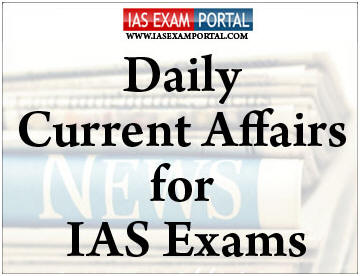(HOT) UPSC Current Affairs 2025 PDF
NEW! The Gist (NOV-2025) | E-BOOKS
Current Affairs for IAS Exams - 27 September 2021

Current Affairs for IAS Exams - 27 September 2021
::NATIONAL::
Ayushman Bharat Digital Mission
- Prime Minister launch Ayushman Bharat Digital Mission on 27th September.
About:
- Ayushman Bharat Digital Mission will create a seamless online platform that will enable interoperability within the digital health ecosystem.
- The Mission will enable access and exchange of longitudinal health records of citizens with their consent.
- The key components of Ayushman Bharat Digital Mission include a health ID for every citizen that will also work as their health account.
- Ayushman Bharat Digital Mission Sandbox, created as a part of the Mission, will act as a framework for technology and product testing that will help organizations, including private players.
- This Mission will create interoperability within the digital health ecosystem, similar to the role played by the Unified Payments Interface in revolutionizing payments.
National Mission on Cultural Mapping
- The National Mission on Cultural Mapping (NMCM) has now been handed over to the Indira Gandhi National Centre for the Arts (IGNCA), which is gearing up for a trial run in 75 villages in October 2021.
About:
- The Culture Ministry had approved the mission in 2017 with a ₹469 crore budget from 2017-2018 to 2019-2020, according to the administrative approval for the project.
- So far 14.53 lakhs artists/artisans have been registered on NMCM portal through secondary sources State/UT-wise. However, no direct benefits or assistance has been extended through this Mission to the registered artists/institution.
- The cultural mapping project had recently been handed over to the IGNCA. He said the work of creating a database for folk arts and mapping of heritage of villages would be carried out over five years.
- Teams of volunteers from the Nehru Yuva Kendra Sanghathan, the National Service Scheme and students of sociology and social work would be deputed to visit villages and collect data on the art forms and heritage of the areas.
CLICK HERE FOR FULL CURRENT AFFAIRS (Only for Course Members)
JOIN Full Online Course for UPSC PRE Exam
UPSC IAS Exam Complete Study Materials
::INTERNATIONAL::
Beijing-Lhasa expressway
- China has completed a key section of the Beijing-Lhasa expressway, a 295 km stretch from Lhasa to Nagqu.
- This section is located at an average altitude of 4,500 metres above sea level which Chinese state media have termed the world’s highest expressway.
- People’s Liberation Army (PLA) has set up surveillance equipment and cameras opposite the Kio Dhura pass.
Joins PLA commands
- The Lhasa-Nagqu section is part of the G6 Beijing-Lhasa expressway and is the first expressway linking Lhasa, the capital of the Tibet Autonomous Region to north Tibet.
- It also connects the PLA’s Central Theatre Command with the Western Theatre Command which is responsible for the border with India, an official source said.
- The completed expressway will pass through seven major cities of China including Beijing, Hebei, inner Mongolia, Ningxia, Gansu, Qinghai and Lhasa with an approximate length of 3,710 km.
First ‘zero waste’ island
- Apo Island became the first of the over 7,000 islands in the Philippines to go ‘Zero Waste’, according to the Global Alliance for Incinerator Alternatives (GAIA).
- A popular tourist destination in the central part of the archipelago, the island village (barangay) of about 1,000 people had been struggling with waste management for years.
Key initiatives taken such as:
- Proper waste segregation at source
- Door-to-door segregated waste collection system
- Use of composting methods
- Establishment of a decentralised materials recovery facility (MRF), where organic wastes are composted and recyclables are aggregated for junk shop sale
- Waste assessment and brand audits to identify waste composition and design a suitable waste management system
::ECONOMY::
GoM set up to rationalise GST rates
- Setting the stage for an overhaul of the multiple tax rates under the Goods and Services Tax regime, the government has tasked a group of ministers (GoM) led by Karnataka Chief Minister Basavaraj S. Bommai with proposing a rationalisation of tax rates and considering the merger of different tax slabs within two months.
About:
- Currently, the GST regime has five broad tax rate slabs of zero, 5%, 12%, 18% and 28%, with a cess levied over and above the 28% on some goods, and special rates for items like precious stones and diamonds.
- Bommai’s seven-member group constituted by the Finance Ministry on Friday includes West Bengal Finance Minister Amit Mitra and Kerala Finance Minister K.N. Balagopal, as well as GST Council members from Goa, Bihar, Uttar Pradesh and Rajasthan.
- The GoM shall review the current tax slab rates and recommend changes in the same as may be needed to garner required resources (and) review the current rate slab structure of GST, including special rates, and recommend rationalisation measures, including merger of tax rate slabs, required for a simpler rate structure in GST.
::SCIENCE AND TECHNOLOGY::
Dark energy
- An international research team made the first putative direct detection of dark energy.
About:
- Dark energy, the mysterious form of energy that makes up about 68% of the universe, has intrigued physicists and astronomers for decades.
- Dark energy has been noted as “the most profound mystery in all of science”.
Dark energy Vs Dark matter:
- Everything we see – the planets, moons, massive galaxies, you, me, this website – makes up less than 5% of the universe.
- About 27% is dark matter and 68% is dark energy.
- While dark matter attracts and holds galaxies together, dark energy repels and causes the expansion of our universe.
- Despite both components being invisible, we know a lot more about dark matter, since its existence was suggested as early as the 1920s, while dark energy wasn’t discovered until 1998.
CLICK HERE FOR FULL CURRENT AFFAIRS (Only for Course Members)

